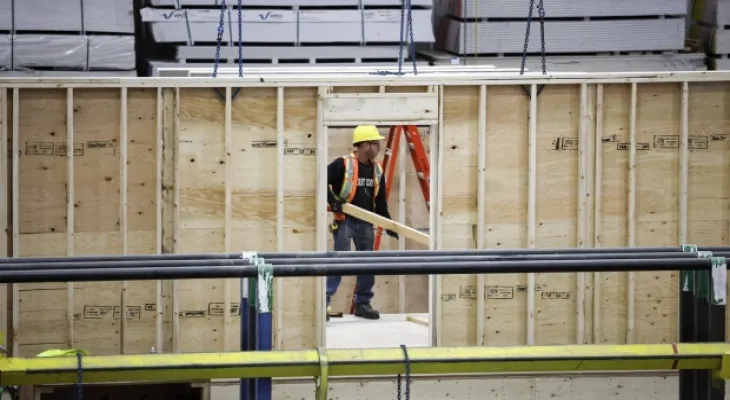Search here
Newspaper
Search here

Arab Canada News
News

Published: April 18, 2024
Experts confirmed that solving the long-term shortage of construction workers will be essential to boost the supply of housing, as the Canada Mortgage and Housing Corporation continues to forecast housing starts that fall short of rising demand.
The Canada Mortgage and Housing Corporation pointed to the growing labor shortage in the construction sector as one of the three factors contributing to extended construction times in last month's housing supply report.
Alongside the volume of large projects and rising costs, the agency stated that workers are retiring faster than they can be replaced. This challenge has been exacerbated by the pandemic, when some construction workers changed careers or retired early instead of returning to the industry as the economy reopened.
Jordan Thompson, Senior Director of Infrastructure Advisory at KPMG in Canada, said: "We knew this was going to happen.”
“However, it has reached quite a point now, where there is so much work coupled only with an overall reduction in the workforce.”
Thompson stated that the industry faces a dual challenge of replacing workers as they retire while trying to grow the sector to meet Canada’s increasing need for homes.
Kevin Li, CEO of the Canadian Home Builders' Association, estimated that 22 percent of housing construction workers are expected to retire over the next decade.
While the labor shortage poses a continuous challenge, he noted that its effects were somewhat muted over the past year as high borrowing costs slowed demand from potential homebuyers in many markets.
But he said a recovery could lead to "more pressure" on the sector.
Li stated, "Once people are able to buy and move and the market starts to turn, at that point, we will indeed see that the labor shortage has become an escalating crisis."
Canada may need an average of more than 500,000 additional construction workers to build all the homes that will be needed from now until 2030, according to a report by RBC's Chief Economist Robert Hogue.
The report, titled "The Great Rebuild," predicts that the pace of housing construction in Canada will need to jump by half just to meet future demographic growth, and presented seven ideas to address the housing shortage in Canada, the first of which is to significantly expand the labor pool in the construction sector.
Hogue said, "Every avenue must be pursued to get more people into this sector," including prioritizing construction skills among new immigrants, setting "ambitious" targets for enrollment in skilled trade schools, and incentivizing older construction workers to stay in the workforce longer.
Hogue added during an interview, "If this is not addressed, for example, by attracting more people to the trades and allowing more trade immigrants to come into our country, this could slow down solving our affordability and housing crisis," "We need to build more."
The federal budget presented on Tuesday acknowledged that the skilled labor shortage contributes to "established structural barriers" that hinder the supply of new housing and increase affordability pressures.
The government stated that it would encourage more people to pursue skilled trades and break down barriers to the recognition of foreign credentials, particularly for construction workers.
It mentioned creating vocational training opportunities "to train and employ the next generation of skilled workers in trades." The budget included $200.5 million allocated for the 2025-2026 period for a summer jobs program "including in sectors facing acute labor shortages, such as housing construction."
Mary Van Buren, President of the Canadian Construction Association, noted that while some strategies being developed are geared towards the long term, prioritizing immigrants with skilled trade backgrounds can give the sector a quicker boost.
She stated that skilled tradespeople comprise about 2% of new Canadians, and while steps have been taken to correct this imbalance, she noted that Canada's points system for evaluating immigration applications still favors those with higher education.
Van Buren added, "You can't create a carpenter or crane operator or project estimator overnight."
Finding solutions is vital not only because of the immediate need— the association has 52,000 active job opportunities— but to help Canada compete with other countries for skilled workers.
Van Buren pointed out that Canada is not alone in trying to resolve the shortage of construction workers.
She said, "The United States, the United Kingdom, Germany, Japan, Italy, and France are facing a similar challenge, all except Japan heavily relying on immigration."
Li mentioned that another reform could include shifting to more factory-built homes in the medium to long term.
He added, "We will need to increase productivity, and this usually has to be done through machinery or robots, that kind of thing."
"There's no doubt that we will need more people, but we will also need more factories to help fill the gap."
About 86 percent of business leaders in real estate and construction say that despite the influx of immigrants, their organizations still lack the skilled talent they need to grow, according to a KPMG survey conducted in February regarding priorities ahead of the federal budget.
Thompson stated that this underscores the need to do things differently, instead of merely waiting for the workforce size to increase. He pointed to the emergence of modular and prefabricated homes, along with increased digital tools aimed at improving productivity on construction sites.
He continued, "It will take time to bring more people in and enable them to go through vocational training and all these things. To be honest, we don’t have time to do that."
"What will help us do things faster is the way we build things. We need to explore different ways to construct housing and execute infrastructure projects that are already complex at a lower cost."
Comments